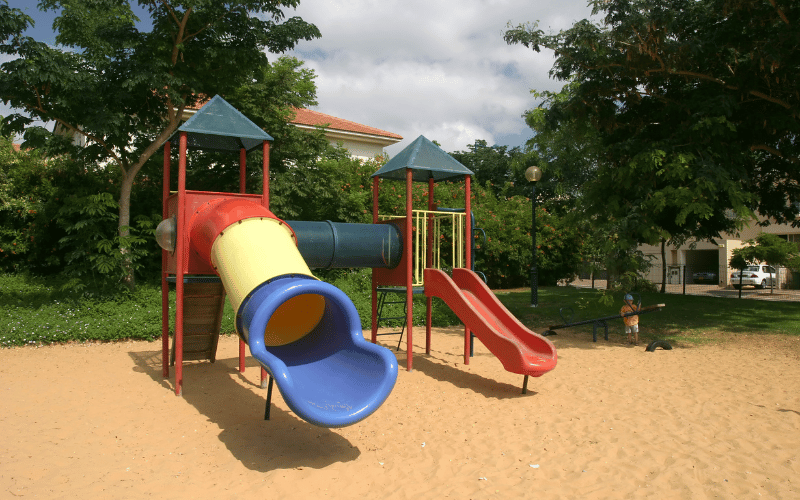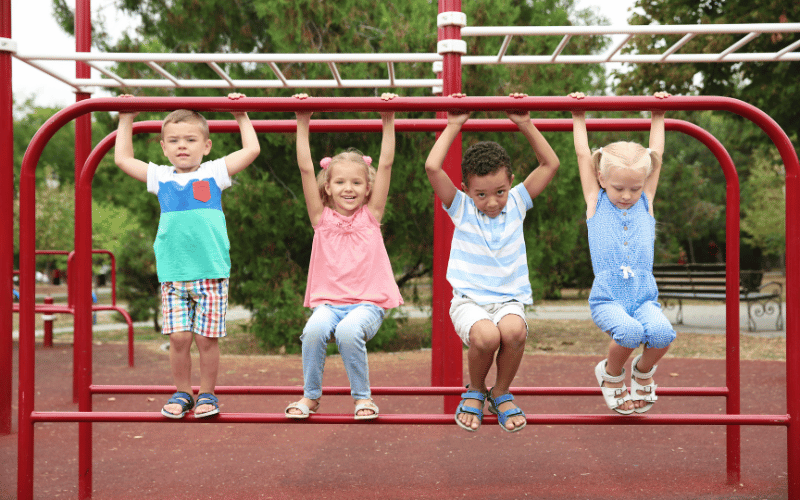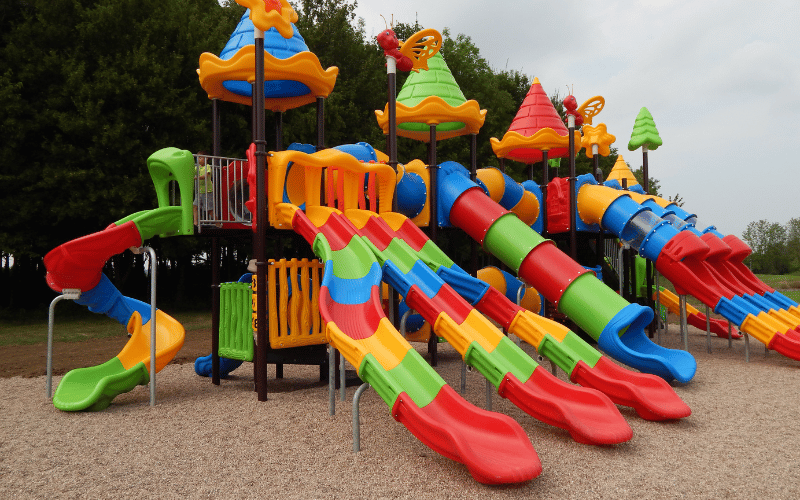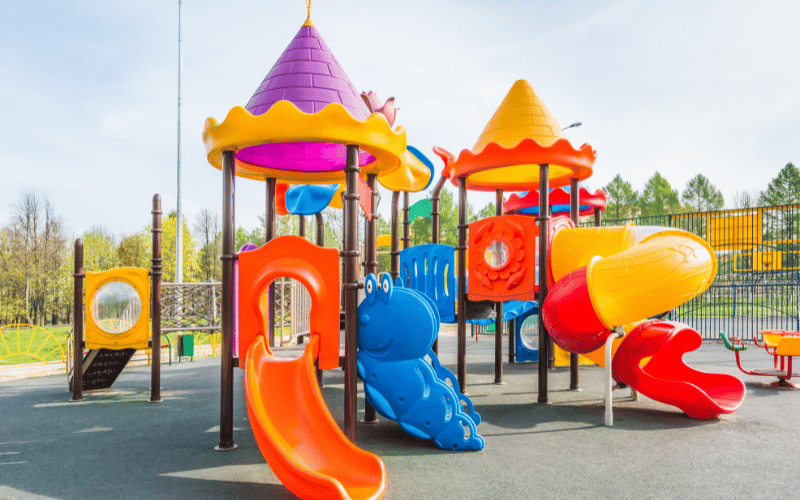Playgrounds do more than provide a space for children to play. They nurture physical strength, spark creativity, and build social skills. Beyond benefiting children, playgrounds also bring communities together, creating spaces where families connect and neighbors bond. Choosing the right equipment plays a critical role in ensuring these spaces are safe, inclusive, and engaging for everyone.
Many park planners and community leaders want to create playgrounds that stand out. But they often feel overwhelmed by the sheer variety of equipment options and the need to balance safety, inclusivity, and budget. I’ve worked with countless clients who face these challenges, and I’ve guided them toward solutions that meet their unique needs.
This guide simplifies the process of selecting playground equipment. It breaks down the key factors to consider, from understanding the needs of your community to customizing equipment for specific age groups and abilities. Whether you’re upgrading an existing playground or starting from scratch, this practical guide will help you make informed decisions that result in a space where children thrive and communities flourish.
Table of Contents
ToggleStep 1: Understanding Your Playground’s Needs
Every successful playground project begins with a clear understanding of its unique requirements. Before diving into equipment catalogs or design ideas, take the time to evaluate the space, define your audience, and set specific goals. This foundational step ensures that every decision you make aligns with the needs of the community and the space itself.
Assessing the Space: Size, Layout, and Condition
Start by walking the site with a critical eye. Measure the available space and note any irregularities in the layout, such as slopes, uneven ground, or existing obstacles like trees or utility poles. These factors will influence the type and placement of equipment. For example, a compact area might benefit from vertical play structures that maximize space, while a larger site could accommodate sprawling zones for different activities.
Pay attention to the condition of the ground. Is the soil stable enough to support heavy equipment, or will you need additional preparation, such as grading or drainage improvements? A site with poor drainage can lead to water pooling, which damages equipment and creates safety hazards. Addressing these issues early prevents costly delays later.
Defining Your Audience: Age Groups and Inclusivity
A playground should cater to the specific needs of its users. Identify the primary age groups you want to serve. For toddlers, focus on low-to-the-ground equipment with soft surfacing, such as crawl tunnels or small slides. For older children, include more challenging features like climbing walls, monkey bars, or zip lines.
Inclusivity is equally important. Consider children with disabilities or sensory sensitivities. Add ramps, accessible swings, and sensory play panels to ensure every child feels welcome. Wide pathways and ground-level activities make the space more navigable for children with mobility challenges. A truly inclusive playground doesn’t just meet standards—it creates an environment where all children can play together.
Setting Goals: Safety, Engagement, and Durability
Define what you want the playground to achieve. Safety should always be the top priority. Choose equipment that meets ASTM and CPSC standards, and plan for surfacing that cushions falls effectively. Engagement comes next—select features that encourage physical activity, creativity, and social interaction. For example, climbing structures build strength and coordination, while interactive panels spark imagination.
Durability is your long-term ally. Opt for materials like powder-coated steel, UV-stabilized plastics, or treated wood that can withstand heavy use and harsh weather. Investing in high-quality materials upfront reduces maintenance costs and extends the playground’s lifespan.
Understanding your playground’s needs is the cornerstone of a successful project. By assessing the space, defining your audience, and setting clear goals, you lay the groundwork for a playground that is safe, engaging, and built to last.

Step 2: Choosing the Right Equipment
Selecting the right equipment is where your playground begins to take shape. Every piece you choose should serve a purpose—whether it’s promoting physical activity, sparking creativity, or ensuring inclusivity. This step requires balancing safety, functionality, and the unique needs of your community.
Safety First: ASTM, CPSC, and ADA Compliance
Safety isn’t just a box to check—it’s the foundation of every decision you make. Start by ensuring all equipment complies with ASTM (American Society for Testing and Materials) and CPSC (Consumer Product Safety Commission) standards. These guidelines cover critical aspects like proper spacing, fall heights, and material safety. For example, slides should have guardrails to prevent falls, and swing chains should be coated to avoid pinched fingers.
ADA (Americans with Disabilities Act) compliance is equally important. This ensures your playground is accessible to children of all abilities. Include ramps, transfer stations, and ground-level play elements to create an inclusive environment. Remember, a safe playground isn’t just about preventing injuries—it’s about creating a space where every child feels secure and welcome.
Essential Equipment Types: Slides, Swings, Climbing Structures, Sensory Play Elements
A well-rounded playground includes a mix of equipment that caters to different types of play. Slides are a staple, but not all slides are created equal. Consider options like wave slides for added excitement or double slides that encourage social play. Swings are another must-have, and you can diversify with bucket swings for toddlers, belt swings for older kids, and inclusive swings for children with mobility challenges.
Climbing structures are essential for building strength and coordination. Look for designs that offer varying levels of difficulty, such as rock walls, rope climbers, or net towers. Sensory play elements, like musical panels, textured surfaces, or water features, engage children’s senses and provide a calming experience for those with sensory sensitivities.
Customizing for Your Community: Themes, Nature-Inspired Elements, and Local Touches
Customization transforms a playground from functional to unforgettable. Start by considering themes that resonate with your community. A nautical theme might suit a coastal area, while a forest theme could complement a park surrounded by trees. Nature-inspired elements, like log climbers or boulder slides, blend seamlessly into outdoor settings and encourage imaginative play.
Adding local touches makes the playground feel uniquely yours. Incorporate colors, symbols, or designs that reflect the community’s identity. For example, a playground near a historic site could include panels with fun facts or artwork inspired by the area’s history. These details create a sense of pride and connection among users.
Choosing the right equipment is about more than filling a space—it’s about creating an environment that inspires play, fosters growth, and reflects the heart of your community. By prioritizing safety, including essential play elements, and adding personal touches, you’ll design a playground that stands out for all the right reasons.

Step 3: Budgeting and Planning
A successful playground project doesn’t just rely on great design and equipment—it also requires careful budgeting and forward-thinking planning. By understanding costs, exploring funding opportunities, and preparing for long-term maintenance, you can ensure your playground remains a valuable community asset for years to come.
Creating a Realistic Budget: Equipment, Surfacing, and Installation Costs
Start by breaking your budget into three main categories: equipment, surfacing, and installation. Equipment costs can vary widely depending on the type and complexity of the structures. For example, a basic swing set might cost a few thousand dollars, while a custom multi-level climbing structure could run into tens of thousands.
Surfacing is another significant expense, but it’s one you can’t afford to skimp on. Engineered wood fiber is a budget-friendly option, but it requires regular replenishment. Poured-in-place rubber or rubber tiles have higher upfront costs but offer durability and lower maintenance over time. Always factor in the critical fall height of your equipment when choosing surfacing to ensure safety compliance.
Installation costs often catch planners off guard. Professional installation is essential for ensuring safety and longevity, so include this in your budget from the start. Don’t forget to account for site preparation, such as grading, drainage, or removing old equipment, as these can add to the overall cost.
Exploring Funding Options: Grants, Sponsorships, and Community Fundraising
If your budget feels tight, don’t let it limit your vision. Many organizations offer grants specifically for playground projects. Research local, state, and national programs that support community development or child-focused initiatives. For example, KaBOOM! and the National Recreation and Park Association (NRPA) often provide funding opportunities for playgrounds.
Sponsorships are another great option. Reach out to local businesses or corporations that might want to contribute in exchange for recognition, such as a plaque or branding on a piece of equipment. Community fundraising can also make a big impact. Host events like bake sales, fun runs, or crowdfunding campaigns to rally support and build excitement for the project.
Planning for Maintenance: Low-Maintenance Materials and Routine Inspections
A playground is only as good as its upkeep. Plan for maintenance from the beginning by choosing low-maintenance materials. Powder-coated steel resists rust, UV-stabilized plastics won’t fade or crack, and treated wood can withstand the elements with minimal care.
Establish a routine inspection schedule to catch wear and tear before it becomes a safety issue. Monthly checks should include tightening bolts, lubricating moving parts, and replenishing loose-fill surfacing. For poured-in-place rubber or tiles, inspect for cracks or lifting edges and address them promptly. Budget for these ongoing costs to avoid surprises down the road.
Budgeting and planning are the backbone of any playground project. By creating a detailed budget, exploring creative funding options, and preparing for long-term maintenance, you’ll set your project up for success and ensure it remains a source of joy and pride for the community.
Step 4: Installation and Final Touches
The installation phase is where your playground vision becomes a reality. Every detail, from site preparation to the final finishing touches, plays a role in creating a safe, functional, and inviting space. Careful execution ensures the playground is ready to welcome children and families for years to come.
Preparing the Site: Drainage, Leveling, and Surfacing
Before any equipment goes up, the site must be properly prepared. Start by addressing drainage. Poor drainage can lead to water pooling, which damages equipment and creates safety hazards. Install a drainage system or grade the site to direct water away from play areas.
Next, focus on leveling the ground. Uneven surfaces can cause instability in equipment and increase the risk of trips and falls. Use compacted soil or gravel to create a stable, even foundation. Once the ground is ready, apply the surfacing material. For loose-fill options like engineered wood fiber, ensure the depth meets safety standards for critical fall heights. For poured-in-place rubber, allow adequate curing time to achieve its full protective properties.
Installing Equipment: Safe Assembly and Proper Spacing
When it’s time to install the equipment, follow the manufacturer’s instructions meticulously. Use the recommended tools and hardware to ensure every piece is securely anchored. Double-check that bolts are tightened, connections are stable, and moving parts, like swings or spinners, operate smoothly.
Spacing is just as important as assembly. Maintain proper clearance between equipment to prevent overcrowding and collisions. For example, swings should have a clear zone in front and behind, while slides need unobstructed space at the bottom for safe landings. Refer to ASTM and CPSC guidelines to ensure your layout meets safety standards.
Adding Finishing Touches: Benches, Shade Structures, and Signage
The finishing touches transform a functional playground into a welcoming community space. Install benches near play areas to give caregivers a comfortable place to sit while keeping an eye on children. Shade structures, whether freestanding or integrated into equipment, provide relief from the sun and make the playground more enjoyable during hot weather.
Don’t overlook signage. Clear, durable signs can communicate important information, such as age-appropriate zones, safety rules, and emergency contact details. If your playground includes inclusive features, highlight them with signage to ensure all visitors know what’s available.
Every step in the installation process contributes to the playground’s success. By preparing the site thoroughly, assembling equipment with care, and adding thoughtful finishing touches, you create a space that is safe, engaging, and ready to bring joy to the community.

Step 5: Long-Term Care and Community Engagement
A playground’s story doesn’t end with its installation. Its longevity and success depend on consistent care and the active involvement of the community it serves. By combining routine maintenance with community engagement, you ensure the playground remains a safe, vibrant, and cherished space for years to come.
Routine Maintenance: Inspections, Repairs, and Surfacing Upkeep
Think of your playground as a living, breathing entity that thrives on attention. Schedule regular inspections to catch issues before they escalate. Monthly checks should include tightening bolts, inspecting for rust or cracks, and ensuring moving parts like swings and spinners operate smoothly. For high-traffic playgrounds, consider weekly visual inspections to spot immediate concerns.
Repairs should never be delayed. A loose bolt today can become a safety hazard tomorrow. Keep a toolkit and spare parts on hand for quick fixes, and partner with a certified playground safety inspector (CPSI) for annual comprehensive evaluations.
Surfacing requires just as much attention as the equipment. For loose-fill materials like engineered wood fiber, rake and level the surface regularly to maintain proper depth and coverage. Replenish the material as needed to meet safety standards. For unitary surfacing like rubber tiles or poured-in-place rubber, inspect for cracks, lifting edges, or wear patterns, and address them promptly to prevent tripping hazards.
Encouraging Community Involvement: Events, Feedback, and Volunteer Programs
A playground thrives when the community takes ownership of it. Host events like cleanup days or seasonal celebrations to bring people together and foster a sense of pride in the space. These gatherings not only keep the playground in top shape but also strengthen community bonds.
Encourage feedback from users. Install a suggestion box or create an online forum where parents, caregivers, and children can share their thoughts. Listening to the community helps you identify areas for improvement and ensures the playground continues to meet their needs.
Volunteer programs are another powerful tool. Organize groups to handle tasks like raking surfacing, planting flowers, or painting benches. When people contribute their time and effort, they develop a deeper connection to the playground and are more likely to help maintain it.
Long-term care and community engagement are the heartbeat of a successful playground. By committing to regular maintenance and involving the community, you create a space that remains safe, inviting, and full of life for generations to come.
FAQs
Q: What are the most critical safety standards for playground equipment?
A: Focus on meeting ASTM (American Society for Testing and Materials) and CPSC (Consumer Product Safety Commission) standards. These guidelines cover critical safety aspects like proper equipment spacing, fall height requirements, and material safety. For inclusivity, ensure compliance with ADA (Americans with Disabilities Act) standards, which guarantee accessibility for children of all abilities. Regularly inspect equipment to ensure it continues to meet these standards over time.
Q: How can I make my playground more inclusive for children with disabilities?
A: Include features like ramps, transfer stations, and ground-level play elements to ensure accessibility for children with mobility challenges. Add sensory play elements, such as musical panels or textured surfaces, to engage children with sensory sensitivities. Wide pathways, accessible swings, and inclusive seating areas also help create a space where all children can play together.
Q: What’s the best safety surfacing option for a tight budget?
A: Engineered wood fiber is a cost-effective option that meets safety standards for fall protection. It’s easy to install and provides good cushioning, but it does require regular maintenance, such as raking and topping up, to maintain its effectiveness. For a slightly higher upfront cost, rubber mulch offers better durability and lower maintenance while still being budget-friendly.
Q: How often should playground equipment and surfacing be inspected?
A: Inspect equipment and surfacing at least once a month to identify wear and tear or potential hazards. For high-traffic playgrounds, conduct weekly visual checks to catch issues early. Schedule an annual inspection with a certified playground safety inspector (CPSI) to ensure compliance with safety standards and address any structural concerns.
Q: How long does a typical playground makeover take?
A: The timeline depends on the scope of the project. Minor updates, like replacing equipment or surfacing, can take a few weeks. Full-scale renovations, including site preparation and new installations, may take several months. Plan for potential delays caused by weather, supply chain issues, or permitting requirements to set realistic expectations.
Conclusion
Thoughtful playground design brings countless benefits, from ensuring safety and fostering inclusivity to creating a space that fills the community with pride. By carefully planning every detail, you can build a playground that inspires joy, encourages growth, and strengthens connections among families and neighbors. Start planning your ideal playground today—whether that means reaching out to trusted equipment providers for expert guidance or sparking a community discussion to gather ideas and support. The perfect playground begins with your first step.






